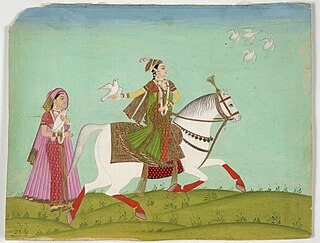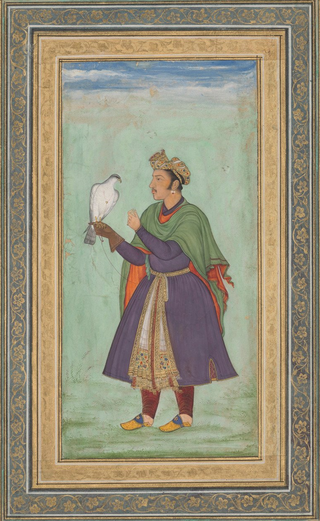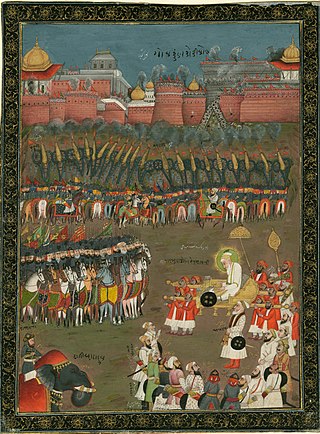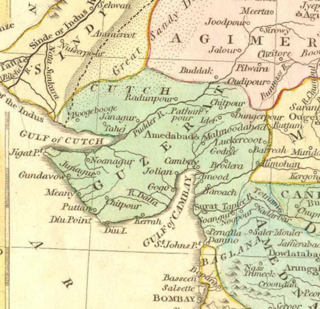
Mirza Shahab-ud-Din Muhammad Khurram,commonly called Shah Jahan I,also called Shah Jahan the Magnificent,was Emperor of Hindustan from 1628 until his deposition in 1658. As the fifth Mughal emperor,his reign marked the zenith of Mughal architectural and cultural achievements.

Sultana Chand Bibi was the regent of the Bijapur Sultanate during the minority of Ibrahim Adil Shah II in 1580–1590,and the regent of the Ahmednagar Sultanate during the minority of her great nephew Bahadur Shah in 1595–1600. Chand Bibi is best known for defending Ahmednagar against the Mughal forces of Emperor Akbar in 1595.

Khusrau Mirza was the eldest son of the Mughal Emperor Jahangir and his first wife,Shah Begum. Being Jahangir's eldest son,he was the heir-apparent to his father but Jahangir favoured his son Khurram Mirza as he held an animosity against Khusrau.
The Farooqi dynasty or the Farooq Shahi was the ruling dynasty of the Khandesh Sultanate from its inception in 1382 till its annexation by the Mughal emperor Akbar in 1601. The founder of the dynasty,Malik Ahmad participated in a rebellion against the Bahmani ruler Muhmmad Shah I in his early years. When he was compelled to flee from Deccan,he established in Thalner on the Tapti River. After receiving the grant of the fiefdoms of Thalner and Karanda from Firuz Shah Tughluq in 1370,he conquered the region around Thalner,which later became known as Khandesh. By 1382,he started ruling independently.

Mahabat Khan,born Zamana Beg,was a prominent Mughal general and statesman,perhaps best known for his coup against the Mughal Emperor Jahangir in 1626. He also served Subahdar of Malwa Subah from 1611 to 1623 and Bengal Subah during 1625–1626. He earned the title Khan-i-Khanan from emperor Shah Jahan.

Mir Shihab-ud-Din Siddiqi,known by his title Ghaziuddin Khan,was a leading military general and noble of Central Asian origin in the Mughal Empire. He was a favoured member of emperor Aurangzeb's court,and the father of Chin Qilich Khan,founder of Hyderabad State. Under Aurangzeb,he distinguished himself in key battles over the Deccan,and held the governorship of Berar Subah. He briefly served as the governor of Gujarat Subah during the reign of Aurangzeb's successor Bahadur Shah,and died in office. He is buried in a madrasa complex he founded during his lifetime,known as Madrasa Ghaziuddin Khan,which is located in Old Delhi.

The Siege of Golconda was an eight-month military siege of the Golconda Fort. This siege was personally directed by the Mughal emperor Aurangzeb against the Golconda Sultanate,ruled by king Abul Hasan Qutb Shah. It was the second Mughal siege of the fort,following an aborted attempt by Aurangzeb in 1656 as a prince of emperor Shah Jahan. The event served as the climax of the Golconda Sultanate,which was annexed into the Mughal Empire as a result of the victory of the siege. The military confrontation was one of the final stages in the Mughal Empire's expansion southwards in the Indian subcontinent.

Daniyal Mirza was a prince of the Mughal Empire who served as the Viceroy of the Deccan. He was the third son of the emperor Akbar and the half-brother of the emperor Jahangir.

Parviz Mirza was the second son of Mughal emperor Jahangir from his wife,Sahib Jamal. His daughter,Nadira Banu Begum,later became the wife of Dara Shikoh.

Sawai Raja Soor Singh or Suraj Mal or Suraj Singh,was the ruler of the Rathore Kingdom of Marwar from 11 July 1595 until his death in 1619. His sister Manavati,also known as,Bilqis Makani was the consort of Mughal Emperor Jahangir and mother of his successor Mughal Emperor Shah Jahan.
Khulasat-ut-Tawarikh is a Persian language chronicle written by Sujan Rai Bhandari in the Mughal Empire of present-day India. It deals with the history of Hindustan,and it also contains details about the contemporary Mughal Empire. Sujan Rai completed the book in 1695 CE,during the reign of Aurangzeb. An insertion about Aurangzeb's death was later added to the original copy by a transcriber.

The Gujarat Subah was a province (subah) of the Mughal Empire,encompassing the Gujarat region. The region first fell under Mughal control in 1573,when the Mughal emperor Akbar defeated the Gujarat Sultanate under Muzaffar Shah III.
Hushang Mirza or Hoshang Mirza was a Mughal prince and grandson of the third Mughal emperor,Akbar. He was son of Daniyal Mirza and nephew of the fourth Mughal emperor,Jahangir.

Sa'adullah Khan,also spelled Sadullah Khan was the Grand Vizier and Vakil-I-Mutlaq of the Mughal Empire during the reign of Shah Jahan I.

Khwaja Sabir,Nasiri Khan or Khan-i-Dauran was an Indian Muslim viceroy of the Deccan and one of the Mughal emperor Shah Jahan’s leading sardars. He received the title "Khan Dauran" during the conquest of Daulatabad. He died in Lahore in 1645 from a knife wound from his own attendant,a Kashmiri Brahmin. He hald the rank of 7,000 horse.

Asad Khan,born Muhammad Ibrahim,was a high-ranking noble of the Mughal Empire during the reigns of Aurangzeb and Bahadur Shah. He is known for his tenure as the wazir of emperor Aurangzeb in the period 1676–1707,and was an important player in Mughal court politics.

The siege of Daulatabad (1633) was a conflict between the Mughal Empire and the Ahmadnagar Sultanate,wherein the fort-city of Daulatabad was besieged by a Mughal force for several months and successfully captured. The Bijapur Sultanate also participated in the conflict against the Mughals,sending a large army to the aid of the fort's garrison. The conflict took place after several Mughal victories securing other minor forts in Ahmadnagar control,but was distinguished by the political significance of Daulatabad to the Ahmadnagar Sultanate. This event marked Mughal victory in the ongoing war between the Mughals and the Ahmadnagar Sultanate;it ended the Nizam Shahi dynasty and concluded the Sultanate,marking another step in the Mughal advance over the Deccan region. The victory did not fully quell resistance to Mughal authority in the Western Deccan;a year later,Maratha commander Shahji Bhonsle attempted a bid for power using a puppet ruler of the Nizam Shahi house.

The Tarikh-i-Khan-Jahani is a 17th-century Persian language text describing the history of the ethnic Afghans. Versions of the work are referred to by the names Makhzan-i-Afghani and Tarikh-i-Khan Jahani Wa Makhzan-i-Afghani. It was sponsored by Khan Jahan Lodi,a high-ranking noble of the Mughal emperor Jahangir,and its principal author was Nimat Allah al-Harawi,a waqia-navis (news-writer) serving the Mughal Empire. It represents the earliest comprehensive history of the Afghans,and the first to tackle their ethnogenesis,codifying several oral histories of the Afghan community. It also contains a biography of Khan Jahan Lodi. The work served as the basis for subsequent written histories of the Afghans.

Fath Khan,also written as Fateh Khan,was a 17th-century political figure of the Ahmadnagar Sultanate,a historical principality spanning the Western Deccan region in the Indian subcontinent. He was the eldest son of Malik Ambar,the Peshwa of the Ahmadnagar Sultanate. He succeeded his father as the Sultanate's de facto ruler after the latter's death in 1626,and served as Peshwa until his imprisonment in 1633. His tenure,lasting less than a decade,spanned the eclipse days of the kingdom;it was characterised by internal strife and political pressure from the Mughal Empire. He played a key role in the kingdom's collapse by defecting to the Mughal Empire,and killed the ruler Burhan Nizam Shah III in the name of Mughal emperor Shah Jahan. His political career came to an end with the Siege of Daulatabad,after which he submitted to the Mughal emperor and became his pensioner.

















